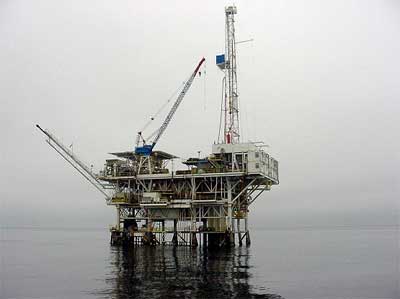Venoco Denies Acidizing Off Goleta Coast
Oil Company Issues Statement Refuting Environmental Report

On Wednesday, one day after a report was released claiming that Venoco Inc. was using a technique known as matrix acidizing to stimulate production from the wells that they access from Platform Holly off of the Goleta coast, the Carpinteria-based oil company issued a brief statement denying that they were using the process for extraction purposes.
“Venoco does not hydraulically fracture or matrix acidize any wells on Platform Holly,” said Venoco spokesperson Lisa Rivas in an email to The Santa Barbara Independent. Instead, she explained, “Acid has been used to clean the well bores drilled from Platform Holly for several decades. This is a process that has been used in onshore and offshore oil wells around the world for generations.”
That’s directly contrary to the report released on Tuesday by the Environmental Defense Center, whose student intern, Matthew Buggert, was funded by a UCSB Coastal Fund grant to research the state’s public records related to the platform, which is offshore of the campus. According to the report and subsequent conversations with EDC attorney Brian Segee, Venoco had, since 2006, applied for and been issued 10 permits whose language suggested that the process was being used to extract more resources rather than just clean wells.
To the EDC and other environmental groups, acidizing, in which hydrochloric and/or hydrofluoric acid is pumped into the ground to free up oil, represents a potentially dangerous situation, since the practice has not undergone extra scrutiny, particularly in regards to offshore drilling. To them, it’s just like hydraulic fracturing, a.k.a. fracking, which has caused a loud and constant nationwide uproar. Like fracking, acidizing is currently being analyzed by State Bill 4, which will establish a brand new set of regulations for these well stimulation techniques by January 2015.
Specifically, Segee said that the records, which were found at the state’s Division of Oil, Gas, and Geothermal Resources in Santa Maria and were also reviewed by a third party expert with oil industry engineering experience, cited one reference to a “pump acid stimulation job” and further references to “acid job”s that used chemicals in the same way. Segee also said that the use of multiple fluids for “preflush,” stimulating, and “overflush” as well as the use of a “diverter” comprised of benzoic acid flakes made them more confident of Venoco’s matrix acidizing. (There is also the process of fracture acidizing, which is basically fracking, but with pressurized acid as a base instead of water and chemicals; the EDC report does not suggest Venoco has done this.)
When asked to further clarify that Venoco was denying the allegations raised in the EDC’s report, Rivas replied again via email on Thursday morning, explaining that the previous statement was all that the company was prepared to say on the matter.
Acidizing aside, that original statement also clarified how the platform works in general. “Platform Holly is a zero-discharge platform — meaning nothing is released to the ocean, not even rain water off the decks of the platform,” said Rivas in the Wednesday afternoon email. “Every drop of fluid is captured and contained. All of Venoco’s offshore and onshore operations are highly regulated and we pride ourselves on adherence to all state and local regulations. The regulators approve all Venoco’s plans for oil development and receive regular reports on all our operations.”



